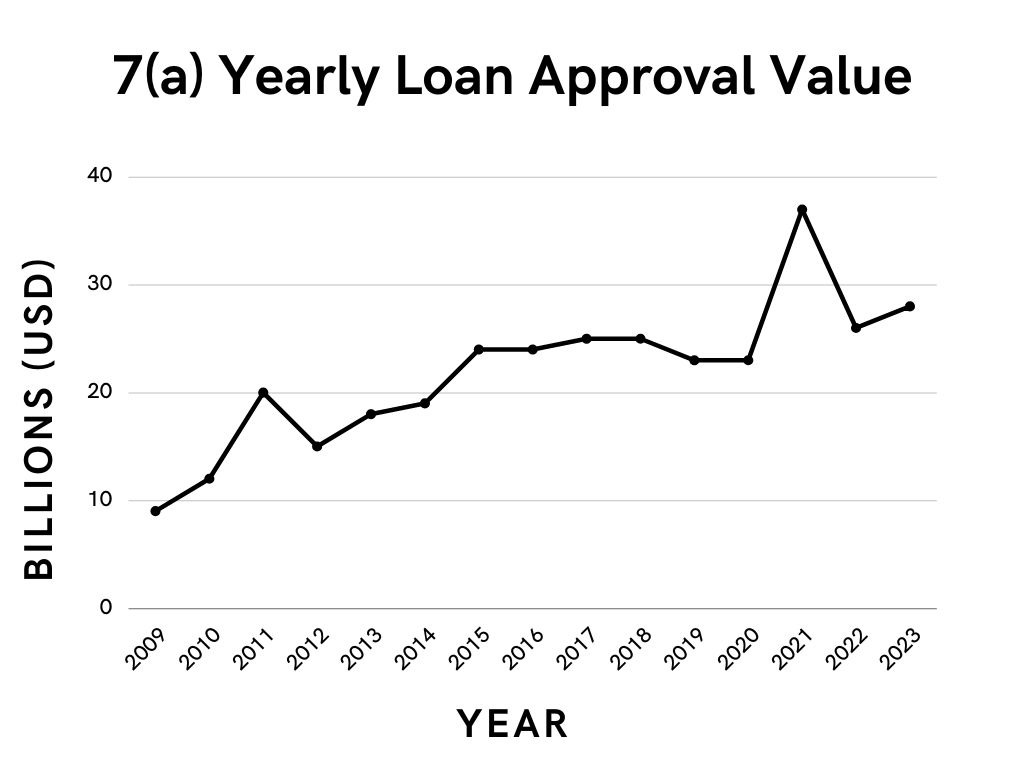SBA 7(a) loans are small business loans that are majority guaranteed for the lender by the U.S. federal government. This is handled by the Small Business Administration (SBA), which is a federal agency intended to promote small business success in the U.S. 7(a) loans are offered and funded by banks and other lenders (just like conventional loans), but as long as the lender follows SBA guidelines, the SBA will guarantee most of the value of the loan for them (75% guaranteed for 7(a) loans >$150,000 in value), regardless of the loan’s outcome. The SBA taking on the majority of the loan’s risk greatly reduces the risk for the lender, allowing them to provide loans to a wider array of borrowers.
7(a) loans are limited to loan values under $5,000,000, perfect for small businesses. They have a prepayment penalty of three years, which is shorter than most conventional loans. This means that you can pay off the full balance of the loan after you’ve had it for only three years, making refinancing the loan a possibility in the near future.
Loan Amount
Up to $5,000,000
Down Payment
Minimum (and typical) down payment of 10%
Interest Rate
Based on the prime rate, typically ranging from prime + 1 to prime + 3
Term
25 years for loans involving real estate, 10 years for loans not involving real estate
Collateral
All available collateral, but not required to be fully collateralized
Personal Guarantee
A full personal guarantee is required
Amortization
Fully amortized
Prepayment Penalty
Period of three years, with descending penalties of 5%-3%-1%
Uses of Proceeds
Valid uses of proceeds include, but aren’t limited to:
Note: 7(a) loans cannot be used for real estate investment, either commercial or residential.
Industries
7(a) loans can be used for almost any kind of for-profit business. Some common industries include:
Fiscal Year 2024
70,242
7(a) Loans Approved
$31 Billion+
Total Value of Approved 7(a) Loans
SBA 7(a) Loans: Pros and Cons
SBA 7(a) loans have many benefits, including their broad accessibility and flexibility and favorable terms, as well as some drawbacks, including a maximum loan amount of $5,000,000 and slightly higher interest rates than other types of loans.
SBA 7(a) Loans vs. Other Types of Loans
SBA 7(a) Loans vs. Conventional Loans
SBA 7(a) loans and conventional loans are popular financing options for small businesses. However, they’re different in many ways, including interest rates, attainability, loan security, and more.
SBA 7(a) Loans vs. SBA 504 Loans
SBA 7(a) loans and SBA 504 loans are popular financing options for small businesses. However, even though they’re both SBA loans, they’re different in many ways, including loan structure, loan process, interest rates, and more.
SBA 7(a) Program History
The U.S. Small Business Administration’s 7(a) Loan Program, established in 1953, has played a key role in fostering the growth and development of small businesses across the country. It was part of the Small Business Act that created the SBA, and named after the part of the bill that detailed the program, Section 7(a). The 7(a) program was designed to provide financial support to small businesses, which often face difficulties in accessing capital from traditional lending sources.
Over the years, the 7(a) Loan Program has evolved to become the SBA’s flagship initiative, offering a variety of loan products to assist small businesses with their financing needs. In most years, the program breaks even, as the low default rate on SBA loans means that revenue from SBA processing fees is usually larger than the total value of paid-out guarantees. The program has been instrumental in job creation, economic growth, and entrepreneurship, supporting small businesses in various industries. Its success has made it a cornerstone of the SBA’s efforts to promote small business development and solidified its place in the storied history of American entrepreneurship.
SBA 7(a) Program Statistics
These are the year-by-year* statistics of the SBA 7(a) loan program from Fiscal Year 1992 to today, including the number of 7(a) loans approved and total approval amount.
7(a) On the Rise


